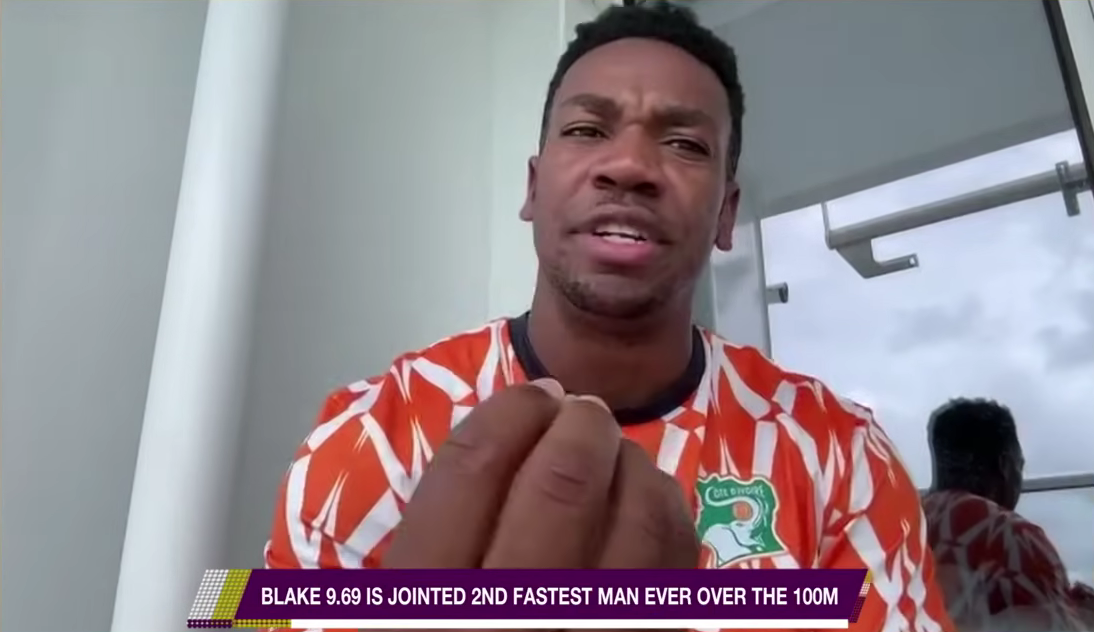Blake on Prize Money: “After Paying Everyone, You Get Nothing” — Misses Golden League’s Rewards
Yohan Blake, joint second fastest 100m sprinter at the “Out D Blocks” podcast
Jamaican sprint legend Yohan Blake opens up about his frustration with the current state of prize money in track and field:
“After paying your agent, your coach, you get nothing,”
he said, reflecting on the same disappointment that many athletes shared with the public over last few months.
“Thank God for everything that I’ve gained. It’s tough. You have to be running those times and you have to be very good to even get the sponsors. With corporate Jamaica it is hard [to find a sponsor]”
For Blake things were different back in the Golden League days — when the rewards stretched further — even for athletes who didn’t make the podium.
2002 Golden League jackpot winners: Hicham El Guerrouj, Felix Sánchez, Ana Guevara and Marion Jones
The Jackpot Was Golden — Literally
Back in 2002, athletes competing in the Golden League were fighting for the ultimate prize — a share of 50 kilograms of gold bars awarded to those who managed to win at each of the season’s events. That year this remarkable feat was achieved by four athletes: Hicham El Guerrouj, Felix Sánchez, Ana Guevara and Marion Jones. For these champions, the Golden League jackpot was a life-changing prize, something that could provide stability for years to come.
Note that today’s market value of the golden jackpot would be $3.35 million. Besides the prize, it was the iconic images of athletes proudly holding these gold bars that added to the standing of the Golden League.
Blake won prize money at the Golden League, but he never won the jackpot. It was Asafa Powell who won $250,000, eventually the only Jamaican athlete to ever win a jackpot in the Golden League. The likes of Sanya Richards (2007) and Wilson Kipketer (1999) walked away with $500,000, Maria Mutola with $1 million (2003).
Important to Blake, the Golden League also rewarded those not finishing at the very top. The rewards were greater back then and athletes who didn’t reach the podium still got paid fairly with prize money sustaining their lives in their home countries.
Diamond League Today: A Tough Reality
The Diamond League, launched in 2010, continues to be the top one-day track series, but the prize money distribution favours the winners. In fact, comparing the prize structures of Golden League and Diamond League Series events, it is evident that the Golden League rewards signifcantly surpassed those paid out by the Diamond League Series events.
Athletes finishing 7th or 8th now walk home with less than $1,000. Blake noted:
“It waters down to $500”
Considering more than two decades of inflation, this is a fraction of what was offered at the Golden League. This lack of financial stability means many elites athletes reconsider their careers in the sport. The Olympic Champion in the discus event, Roje Stona, is one of many decorated athletes who would consider an average career in other sports, such as the NFL, to make a better living.
Michael Johnson, Grand Slam Track
Grand Slam Track: High Stakes and Rewards
In response to these challenges, Michael Johnson launched Grand Slam Track which offers a $100,000 prize for winners in all of the series events.
However, Grand Slam Track’s model has raised concerns about fairness as it primarily focuses on running events and caters to elite athletes, leaving many others without opportunities to compete for significant prizes.
“I think it's a good thing, but only speaks to few. How many people can get there and they're choosing who they want. I don't feel it should be like that,”
Blake commented when asked about upcoming meet formats. The exclusivity of Grand Slam Track risks sidelining talented runners who do not regularly run world-class times or add less media exposure and fan base to the events.
Similarly to Johnson, Alexis Ohanian’s Athlos has made waves by offering $60,000 to winners of its all-women’s events — excluding half of all athletes from competing.
Athlos NYC 2024
Though Grand Slam Track and Athlos focus on the most profitable and marketable subset of athletes, they will eventually better connect with fan communities and hopefully evolve with the times.
“We will push our superstar racers to break new ground in their personal storytelling, competitive success and marketability.”
said Michael Johnson right after launching Grand Slam Track. Both Johnson and Ohanian work with a staff team that brings in experiences from other sports that managed to fascinate and attract fans around the world.
The secret may not be gold bars this time, but rather effective media strategies. Understanding the connection between sports and social media content creation is vital and new formats have already proven their ability to transform track & field and draw in new fans.
Subscribe to our newsletter and receive our track articles free of charge!



